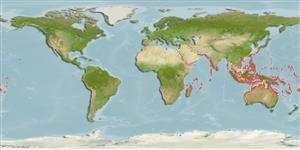Common names from other countries
Environment: milieu / climate zone / depth range / distribution range
Ecologie
marien rifbewoner; diepte 0 - 80 m (Ref. 9773). Tropical; 32°N - 34°S, 27°E - 170°W
Indo-Pacific: East Africa and eastward through northern Australia to Samoa; north to southern Japan. Replaced by closely related Sufflamen albicaudatus in the Red Sea (Ref. 37816).
Grootte / Gewicht / Leeftijd
Maturity: Lm ? range ? - ? cm
Max length : 30.0 cm TL mannelijk / geslacht onbekend; (Ref. 30573)
Dorsale stekels (totaal): 3; Dorsale zachte stralen (totaal): 26-28; Anale stekels 0; Anale zachte stralen: 23 - 26. Juveniles dark brown above, white below (Ref. 1602). Adult variable in color; the bar running through the pectoral base can either be yellow or black, and some individuals may be largely yellowish posteriorly (Ref. 1602).
Inhabit coastal to outer reefs. Habitats from silty lagoons to pristine outer reef walls (Ref. 48637). Occur in shallow lagoon and seaward reefs. Solitary and territorial. Feed on a wide variety of invertebrates. Also taken by drive-in nets (Ref. 9770). Oviparous (Ref. 205). Monogamous (Ref. 52884). Minimum depth reported taken from Ref. 128797.
Levenscyclus en paargedrag
Maturiteit | Voortplanting | Paaien | Eieren | Fecunditeit | Larven
Male defends a defined territory, within which a female resides. On the day prior to spawning, female pushes her snout into the sandy bottom repeatedly and removes small stones and pieces of coral at several sites. Adhesive eggs are deposited on the sandy bottoms or in a small cavity of the reef covered with sand. Female fans the eggs and defends the nest, while male patrols around female (Ref. 8603). Females are territorial, solely tending and guarding the eggs (Ref. 116451). Males exhibit polygyny (Ref. 116451).
Myers, R.F., 1991. Micronesian reef fishes. Second Ed. Coral Graphics, Barrigada, Guam. 298 p. (Ref. 1602)
Status op de Rode Lijst van het IUCN (Ref. 130435)
CITES (Ref. 128078)
Not Evaluated
Gevaar voor de mens
Harmless
Gebruik door de mens
Visserij: van minder commercieel belang; Aquarium: Commercieel
Meer informatie
ReferentiesAquacultuurAquacultuurprofielKweeklijnenGeneticaElectrophoresesErfelijkheidZiektesVerwerkingMassaconversie
Tools
Speciale rapporten
Download XML
Internetbronnen
Estimates based on models
Preferred temperature (Ref.
115969): 24.8 - 29.3, mean 28.4 (based on 3050 cells).
Fylogenetische diversiteitsindex (Ref.
82804): PD
50 = 0.5312 [Uniqueness, from 0.5 = low to 2.0 = high].
Bayesian length-weight: a=0.02042 (0.01188 - 0.03509), b=2.94 (2.79 - 3.09), in cm Total Length, based on LWR estimates for this species & (Sub)family-body (Ref.
93245).
Trofisch niveau (Ref.
69278): 3.8 ±0.20 se; based on food items.
Weerstandsvermogen (Ref.
120179): Gemiddeld, minimale populatieverdubbelingstijd 1,4-4,4 jaar (Preliminary K or Fecundity.).
Fishing Vulnerability (Ref.
59153): Low vulnerability (20 of 100).
